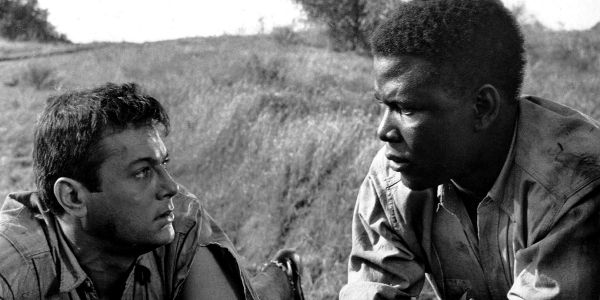Actor Profile: Sidney Poitier

Zac Hestand earned a BA in Film from the University…
Actor Sidney Poitier was born in Florida on February 20, 1927, but raised in The Bahamas. The son of farmers, Poitier grew up in impoverished conditions with very little formal education. He left The Bahamas at the age of fifteen to Miami, where he would encounter both racism and prejudice. Two things that were alien to him in his previous country, but racism and prejudice would define who he is in his development as an actor.
Poitier found racism for the color of his skin, and prejudice for his accent and poor educational background (he could barely read prior to becoming an actor). On a whim, he decided to try his hand at acting, and began auditioning for theatre groups in Harlem. His time involved with the American Negro Theatre of Harlem led to bit parts on Broadway. In 1950, he made his film debut in No Way Out. His role brought him acclaim, and led to what was unusual at time, leading movie roles for a black actor.
There were African-American actors prior to Poitier, such as Hattie McDaniel from Gone with the Wind (the first African-American to win an Oscar). Unfortunately, due to the racist climate at the time, many of these performers were reduced to playing servant roles or reduced to moving in the background of the white actors. Poitier is a trailblazer in that his performance in his film debut led to leading roles and ultimately to become the first black male to win a Best Actor Oscar.
As an actor, Poitier brought to his characters men trapped on the fringes of society. Poitier’s characters often fought to be both treated fairly and achieve the same dreams as the white characters. Alternatively, his characters often witness wrongs committed toward him, those around him and is the one who must rise to fix this alleged wrong. His characters, often strong-willed and articulate, gave a voice to those who did not have a voice. He is a hero that those audiences cheer for and want to emulate.
The following films selected will show the various trials and tribulations faced by Sidney Poitier’s characters, and how these onscreen heroes overcome their obstacles.
Blackboard Jungle (1955)
Richard Dadier (Glenn Ford) plays a teacher at an inner-city high school, where he attempts to connect with his troubled students. The film is innovative in its use of rock music on the soundtrack and for showing an honest portrayal of troubled teenagers. Poitier plays one of the students, who gets singled out due to his race.

Many bad things happen to Dadier, and at first he suspects that Poitier’s character is giving him a hard time, considering that he shows a dominant personality among the student population. Dadier is mistaken, the bad things are organized by a white student, played by Vic Morrow. Poitier in his performance shows his teacher there is more to him beyond his appearance.
Poitier’s character has skill in music and has an aptitude for academics. With his voice and confidence, he shows his white teacher there is more to him than the color of his skin. Dadier eventually becomes close to him, and together they confront Morrow’s troubled and racist character.
In Sidney Poitier’s other film analyzed, he is literally chained to a racist rival.
The Defiant Ones (1958)
Sidney Poitier and co-star Tony Curtis play two convicts chained together. Both despise one another on racial grounds, as well as clashing personalities. They escape from their prison truck, and flee together on foot through the backwoods of the American South.

The men start off hating one another, but learn they must depend on each other to survive. As the plot progresses, the hate slowly turns to friendship, and the two men eventually learn that they aren’t so different after all.
As the film is set in the American South, there are several scenes where the characters encounter locals. The locals respond with bigoted remarks toward Poitier, and as Curtis spends time with him, learns the wrong of his racist ways. Poitier portrays a man who dreams the way all people do, but shows us the limitations of them, especially within the southern setting, he does not feel truly free.
The following film shows Poitier trying to achieve his dream in a family atmosphere.
A Raisin In The Sun (1961)
A film adaptation of the 1959 play of the same name, it was adapted by the playwright herself, Lorraine Hansberry, who, like Sidney Poitier, is a trailblazer. Her play was the first play written by an African-American to debut on Broadway, it went on to be nominated for four Tony awards and won the New York Drama Critics’ Circle award for best play. Poitier originated the stage role of Walter Younger, the son, and revives his role for the film version.

The Younger family waits for the arrival of a life insurance check of $10,000 from the death of the family patriarch. Each member has an idea of what they want to do with the money. Walter is a chauffeur for a white businessman and dreams to use the money to open a liqueur store with his friends. He tires of working for someone else and wants to be his own boss.
The play and film give us characters that were fresh at the time. Many plays and films featured black characters, but were regulated to secondary servant roles. A Raisin in the Sun shows us the servants (Walter’s wife cleans houses for white families) when they go home, and as our featured characters. Life from their point of view and their hopes and dreams.
The story ends not with the opening of a liqueur store, but the money used to buy a new home with a yard. However, the house is in a predominately white neighborhood that witnessed racial violence in the past. The family decides to move there despite protests from a white neighborhood spokesman. Though he did not open a business, he moves his family to a potentially hostile environment in order to achieve a better and new life.
In the final two films examined, Sidney Poitier portrays characters thrown in a hostile, non-accepting environment, and how his characters react to it.
In The Heat Of The Night (1967)
Poitier plays Virgil Tibbs, a big city police detective summoned to a small, southern town to investigate a homicide. He’s assigned to work alongside the bigoted chief of police, Gillespie (Rod Steiger) and endure the racial culture of a small Mississippi town. A far cry from the city of Philadelphia where Tibbs is a respected detective.

Virgil Tibbs is a character that demands and deserves respect. Poitier portrays him with his distinct strong-willed and articulate manner. These small town types may mock him, but he does not let their ignorance get in the way of the case. He impresses locals with his police experience,attention to detail and dedication to solve the crime.
Like Tony Curtis in The Defiant Ones, Gillespie hates Tibbs at first, but eventually becomes friendly toward him. He learns to respect him as a fellow officer and human being.
The film won the Oscar for Best Picture that year, and that same year, Sidney Poitier played a character caught in a hot button national issue: interracial marriage.
Guess Who’s Coming To Dinner (1967)
Interracial marriage, much like same-sex marriage for the 21st century, used to be on a state-by-state basis. Prior to the Supreme Court ruling, same-sex marriage would be legal in New York, but illegal and not recognized in Alabama; for example. Interracial marriage faced these same hurdles in the previous century.
Interracial marriage was primarily not recognized in southern states until the case of Loving v. Virginia made interracial marriage national law in June of 1967, six months prior to the film opening. With a line of dialogue about their marriage not recognized in some states made it dated upon arrival, the central idea of the film is not: acceptance.

Poitier plays John Prentice, a doctor visiting the parents of his wife-to-be, Joanna (Katharine Houghton) and they are surprised by their daughter’s choice for a husband. Though the parents present themselves as progressive white liberals on racial equality, they show hidden prejudice when it comes to their daughter. Through the course of the film, Poitier tries to win the affection and approval of his future in-laws. In the end, he succeeds.
Sidney Poitier portrays his character, as with his other characters, as strong-willed and willing to fight for the right to be equal. In the film, he says his father thinks of himself as a black man, but Prentice thinks of himself as a man. Not to see people as colors, but as individuals. In the end, he wins the girl and parental acceptance.
Sidney Poitier: Final Thoughts
At the start of the 1970’s, Poitier reduced his time onscreen to focus on work behind the camera. He did star and direct himself in the films Buck and the Preacher and Uptown Saturday Night, both popular at the time. His most financially successful directorial feature is the Richard Pryor/Gene Wilder comedy Stir Crazy, the highest grossing film by a black director at the time.
Poitier’s performances as characters that are strong-willed, brave and fight for their beliefs paved the wave for future African-American stars like Denzel Washington, and his directing of Hollywood movies with name stars opened doors for filmmakers like Spike Lee, John Singleton and more recently, Jordan Peele (Peele’s Get Out is essentially Guess Who’s Coming to Dinner as a horror movie).
Though he is long retired from the movies, his barrier breaking continues to live on and inspire future generations of actors to play strong-willed characters that fight for the chance to have the same opportunities as those around them.
Is there a film of Sidney Poitier’s I left out? Which classic is your favorite? Please comment below.
Does content like this matter to you?
Become a Member and support film journalism. Unlock access to all of Film Inquiry`s great articles. Join a community of like-minded readers who are passionate about cinema - get access to our private members Network, give back to independent filmmakers, and more.
Zac Hestand earned a BA in Film from the University of Nevada Las Vegas, and MA in English from the University of Sheffield. He is currently at work on his first book.












